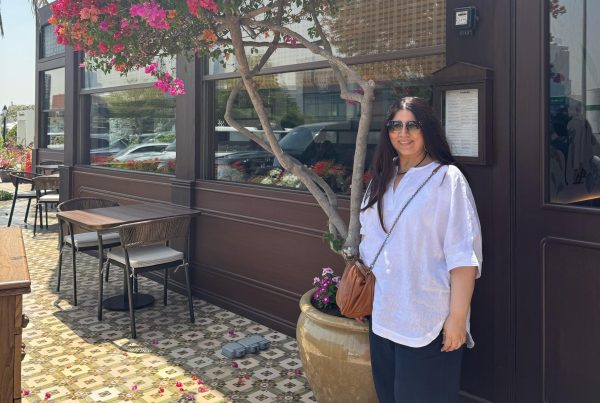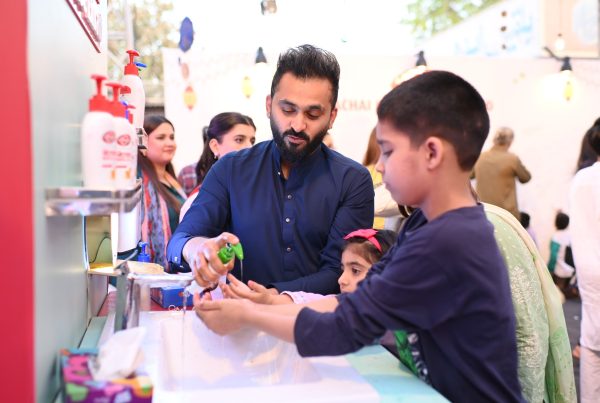This is the unedited version of the story that appeared in Hindustan Times on April 29, 2013. You can read the published version here

The first Sana Safinaz Store at Dolmen City Mall, Karachi has been drawing in crowds. Like high-end boutiques anywhere in the world, only 15 ladies are allowed in at a time. Photo courtesy Salima Feerasta
It’s been little over a decade since an organized fashion industry emerged in Pakistan, five years since the first fashion week unrolled it’s catwalks to buyers and the media. The industry is barely adolescent but fashion has snowballed beyond imagination despite the odds, which are many.
You would think that establishing a fashion industry in Pakistan would be as difficult as dancing on the lip of a volcano. Talibanisation, economic crunch, power failures and lack of law and order (resulting in crime surges) are just some of the reasons that come to mind as deterrents. But fashion has become the essential ‘feel good factor’ for more than the average fashionista. It isn’t rebellion against the conservatives, as many foreign journalists like to play up the ‘Tattoos versus Taliban’ stereotype but it is most certainly and most simply, much needed retail therapy. It’s no wonder that fashion-related stories feature as regular suffixes to the nine o clock news. Pakistan does have two fashion councils and half a dozen fashion weeks a year.
Designers are very clear that it’s bridal couture that butters their bread; in fact it even bakes it. And these coveted wedding ensembles can set the bride’s father (or father-in-law, depending upon who’s paying) several hundred thousand rupees (PKR) back. Rarely are they taxed, since they are ordered within private studios, which leave designers dancing all the way to the bank.
Pakistani designers are also dancing their way across the border with their wedding wear. Revivalists and couturiers Bunto Kazmi and Faiza Samee enjoy a time-tested relationship with Delhi, where they have been privately retailing exquisitely crafted garments for decades. Sana Safinaz, undoubtedly fashion’s most coveted name in Pakistan, is a brand equally popular in India. Their ‘luxury pret’ exhibitions at Tina Tahiliani’s boutique Ensemble are reportedly sold out within the first ten minutes of opening time.
While trade between India and Pakistan is still not kosher for fashion, designers and boutique owners have managed to find a passage to India via Dubai and vice versa. The first Pakistani boutique in India – the PFDC Boulevard – inaugurated several months ago. It is owned and operated by Indian designer and retailer Mini Bindra (which makes it legal) and stocks a gorgeous variety of Pakistan’s top names. Besides the PFDC Boulevard, Pakistani designers frequent boutiques like Ogaan and Kimaya with exhibitions and even organize private showings to a discerning and rich clientele. Those who don’t want to bother with the Dubai route simply stock up a couple of suitcases and visit friends or family.
Indian fashion is just as popular in Pakistan, which is why Pakistani socialite Zeba Husain brought Ensemble to Karachi several years ago. With branches in Karachi and Lahore, she now officially stocks names like Sabyasachi Mukherjee and Ritu Kumar alongside Pakistani designers. Husain is a regular buyer at Indian fashion weeks and believes the market for Indian design is flourishing in Pakistan, especially for Indian wedding wear.
Thanks to Pakistan’s swelling population, there will always be women to be married and therefore nothing poses a threat to the industry of wedding fashion. However, bridals may have been the aim and objective of a designer looking for fame and fortune ten years ago but today the industry is equally ignited by high street fashion for the rising middle class. Multi-label boutiques are opening in the three major cities – Karachi, Lahore and Islamabad – a new boom is coming with e-commerce. Pakistan’s first fashion retailer Zahir Rahimtoola recently took his store, Labels online, an essential step to counter frequent shut-downs in the city. Also, high street stand alone stores are mushrooming as fashion becomes a high equity commodity and ultimately, there is the humble fabric – lawn – that everyone wants to wrap around.
Lawn, an indigenous Pakistani summer fabric that resembles voile and muslin, has been in production for decades but it was only recently that a new trend for ‘designer lawn’ began. Designers were either commissioned to design prints for textile mills or the ones with resources started printing their own fabric. In either case, one season’s lawn could easily filter several million rupees (PKR) into a designer’s account. Mega brands like Gul Ahmed reported an annual turnover of 5000 million for lawn alone. Interestingly, this year saw Indian fashion designer J.J. Valaya make a debut by launching his first collection of lawn prints for Five Star Textile Mills.
Bridals and lawn are two ends of fashion’s very colourful spectrum in Pakistan but in between lies affordable, high street ready to wear for the rising middle class. With more and more women in urban centres taking on corporate jobs, the demand for smart, ready to wear clothing is burgeoning, which is why almost all designers are dipping their toes into R2W.
Given the menace of the radical element, billboards do get vandalized and models’ faces do get covered in black paint. But that has simply pushed the adverts higher on the horizon; the fashion circuit continues to click its Louboutins and paint the town red. Women are wearing suits to work. House maids have traded their shalwars for straight pants. Bottom line: fashion designers do not feel threatened. On the contrary it’s fashion that poses a bigger threat, to the bank balance, men feel!













